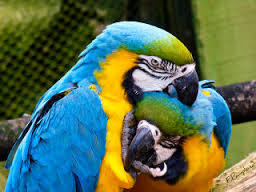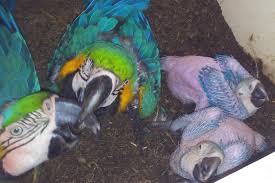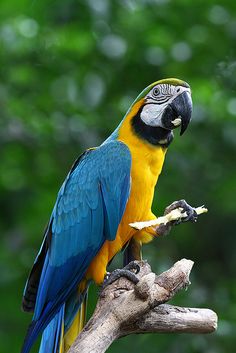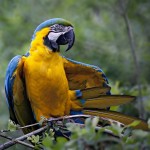The blue-and-yellow macaw, also known as the blue-and-gold macaw, is a large South American parrot with blue
top parts and yellow under parts. It is a member of the large group of neotropical parrots known as macaws.
It inhabits forest (especially varzea, but also in open sections of terra firme or unflooded forest) and
woodland of tropical South America. They are popular in aviculture because of their striking color, ability
to talk, ready availability in the marketplace, and close bonding to humans.
Description
These birds can reach a length of 76-86 cm (30-34 in) and weigh 0.900–1.5 kg (2-3 lb), making them some of
the larger members of their family. They are vivid in appearance with blue wings and tail, dark-blue chin,
golden under parts, and a green forehead. Their beaks are black. The naked face is white, turning pink in
excited birds, and lined with small, black feathers. Blue-and-yellow macaws live from 30 to 35 years in the
wild and reach sexual maturity between the ages of 3 and 6 years.
Little variation in plumage is seen across the range. Some birds have a more orange or "butterscotch"
underside color, particularly on the breast. This was often seen in Trinidad birds and others of the
Caribbean area. The blue-and-yellow macaw uses its powerful beak for breaking nutshells, and for climbing
up and hanging from trees.
Distribution and habitat
This species occurs in Venezuela and south to Peru, Brazil, Bolivia, and Paraguay. The range extends
slightly into Central America, where it is restricted to Panama. The species' range formerly included
Trinidad, but it became extinct there by 1970 as a result of human activities. Between 1999 and 2003,
wild-caught blue-and-gold macaws were translocated from Guyana to Trinidad, in an attempt to re-establish the
species in a protected area around Nariva swamp. A small breeding population descended from introduced birds
is found in Puerto Rico, and another has inhabited Miami-Dade County, Florida, since the mid-1980s.
Breeding
The blue-and-yellow macaw generally mates for life. They nest almost exclusively in dead palms and most nests
are in Mauritia flexuosa palms. The female typically lays two or three eggs. The female incubates the eggs
for about 28 days. One chick is dominant and gets most of the food; the others perish in the nest. Chicks
fledge from the nest about 97 days after hatching. The male bird's color signals readiness for breeding. The
brighter and bolder the colors, the better the chance of getting a mate.
Poultry farming
Blue-and-yellow macaws are popular as pets because of their vivid appearance and ability as a talking bird;
however, their large size makes accommodation problematic, and they tend to require more effort and knowledge
from owners than more traditional pets such as cats or dogs. They are very intelligent and social birds that
bond very closely to their owners, however, so for people who are able to provide for their needs, they make
great and loving companion parrots.
Even well-tended blue-and-yellow macaws are known to "scream" and make other loud noises. Loud vocalizations,
especially "flock calls", and destructive chewing are natural parts of their behavior and should be expected
in captivity. Due to their large size, they also require plentiful space in which to fly around. According
to World Parrot Trust, an enclosure for a blue-and-yellow macaw should, if possible, be at least 15 m
(50 ft) in length.
Status
The blue-and-yellow macaw is on the verge of being extirpated in Paraguay, but it still remains widespread
and fairly common in a large part of mainland South America. The species is therefore listed as Least Concern
by BirdLife International. It is listed on CITES Appendix II, trade restricted.









